Knowde Enhanced TDS
Identification & Functionality
- Chemical Family
- Chemical Name
- INCI Name
- Ingredient Origin
- CASE Ingredients Functions
- Cleaning Ingredients Functions
- Cosmetic Ingredients Functions
- Fluids & Lubricants Functions
- CAS No.
- 69011-36-5
- EC No.
- 500-241-6
- Technologies
- Product Families
Features & Benefits
- Benefit Claims
- Labeling Claims
- CASE Ingredients Features
- HII Features
Applications & Uses
- Markets
- Applications
- Compatible Substrates & Surfaces
- Fluids & Lubricants Type
- Fluids & Lubricants End Use
- Home Care Applications
- I&I Cleaning Applications
- Industrial Additives End Use
Properties
- Physical Form
- Appearance
- Clear Liquid
- Miscible In
- Water
- Typical Properties
| Value | Units | Test Method / Conditions | |
| Cloud Point (10 % in 25% butyl diglycol solution) | 76-78 | °C | DIN EN 1890 |
| pH (2 % in fully demin. water) | 5-7 | - | DIN EN 1262 |
| Viscosity at 20°C (Brookfield) | approx. 130 | mPa.s | DIN ISO 3841 |
| Iodine Color Number | max. 2 | mg I/100 ml | DIN EN 1557 |
| Polyethylene Glycol Content | max. 2.0 | % mass | HPLC |
| Dry Content | 90 ± 1 | % mass | DIN EN ISO 3251 |
| Ignition Temperature | approx. 360 | °C | DIN 51794 |
| Setting Point | max.-10 | °C | DIN ISO 3841 |
| Refractive Index | approx. 1.453 | - | DGF C - IV 5 |
| Density at 20°C | approx. 1.01 | g/ml | DIN 51757 |
Regulatory & Compliance
Technical Details & Test Data
- Free Alcohol Content
Purity
The MARLIPAL O13 products have a high active content of alkylpolyglycol ethers. Depending on the degree of ethoxylation, the products also contain varying amounts of the starting material isotridecanol. The free alcohol, the proportion of which decreases with increasing degree of ethoxylation supports the cleaning action of the ethoxylates and contributes to foam regulation.
During the ethoxylation, secondary reactions yield polyethylene glycols having the structure H(OCH2CH2) nOH. The proportion of polyethylene glycols having varying chain lengths is below 2 %. Polyethylene glycols are water-soluble products which do not impair the properties of the nonionic surfactants.
To neutralize the alkaline catalyst required for the ethoxylation reaction, MARLIPAL O13 grades are treated with shortchain organic acids (usually acetic acid or lactic acid) and adjusted to a pH of 5–7 (2 % in water). Accordingly, they contain a small amount of organic salt and small amounts (less than 0.5 %) of water. The water content, however, may increase on exposure to air since ethoxylates are hygroscopic.
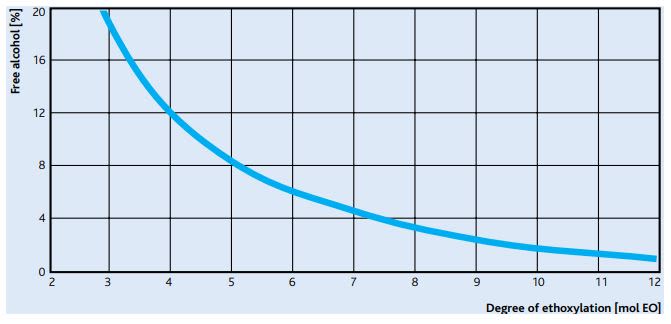
- Wetting Efficiency
Wetting Efficiency on Textiles:
Wetting efficiency on cotton as a function of degree of ethoxylation (1 g/l in demin. water, 20 °C)
In detergents, the surfactants are the active force which removes grease, soiling and pigment particles from the fibers. The wetting efficiency on textiles is therefore an important criterion for assessing the performance of a surfactant. The products of the MARLIPAL O13 series have high wetting efficiency on textiles, the best values being observed for MARLIPAL O13/60 to MARLIPAL O13/100. The wetting effect, which, in accordance with DIN EN 1772, corresponds to the time taken for a cotton disk to sink, is shown in Figure 3 as a function of the degree of ethoxylation. The shorter the sinking time, the better the wetting efficiency.In detergents, the surfactants are the active force which removes grease, soiling and pigment particles from the fibers. The wetting efficiency on textiles is therefore an important criterion for assessing the performance of a surfactant. The products of the MARLIPAL O13 series have high wetting efficiency on textiles, the best values being observed for MARLIPAL O13/60 to MARLIPAL O13/100. The wetting effect, which, in accordance with DIN EN 1772, corresponds to the time taken for a cotton disk to sink, is shown in Figure 3 as a function of the degree of ethoxylation. The shorter the sinking time, the better the wetting efficiency.

Wetting efficiency on hard surfaces:
Wetting efficiency on hard surfaces as a function of degree of ethoxylation (1 g/l in demin. water, 25 °C)
The wetting behavior of surfactant solutions on hard surfaces, such as glass, ceramics, steel and plastics, can be assessed by wetting angle investigations. Good wetting on hard surfaces can be recognized from how much the shape of the droplet of a surfactant-containing aqueous droplet, traced onto the surface of the material, deviates from the shape of a droplet of pure water. The parameter measured is the wetting angle of the droplet. A high reduction of the wetting angle corresponds to good wetting properties on a given substrate . Polypropylene and steel are wetted very well, the optimum range being from 6-8 mol of ethylene oxide per mol alcohol.
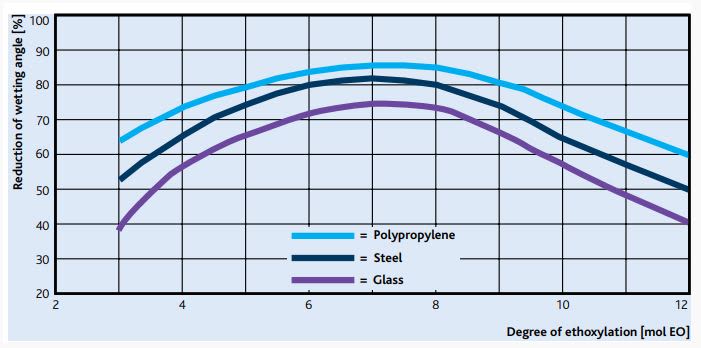
- Foaming Profile
Foaming profile in accordance with DIN EN 12728 (1 g/l in demin. water, 20 °C)
Like all nonionic surfactants, the MARLIPAL O13 ethoxylates produce less foam than anionic products. The foaming profile of the MARLIPAL O13 surfactants is shown in graph and has been determined by the Schlag foam method (DIN EN 12728). The MARLIPAL O13 products containing 8-12 mol of EO/mol produce foam volumes of 100-250 ml in the test, whereas the short chain product grades with lower solubility in water produce significantly less foam. The foaming profile is well within the typical range of alcohol ethoxylates. In comparison, an anionic surfactant such as linear alkylbenzene sulphonate (LAS) produces a foam volume of ca. 600 ml.
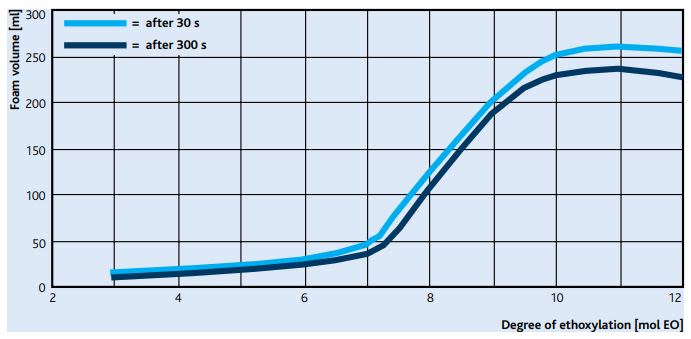
- Detergency on Textiles
The MARLIPAL O13 surfactants have excellent detergency performance both on synthetic and on natural fabrics. The performance on polyester, cotton/polyester blend and cotton was investigated. There are optima in the detergency in the range from 6-10 mol EO, which shift to higher degrees of ethoxylation at a higher washing temperature.
Detergency on polyester at 30 °C
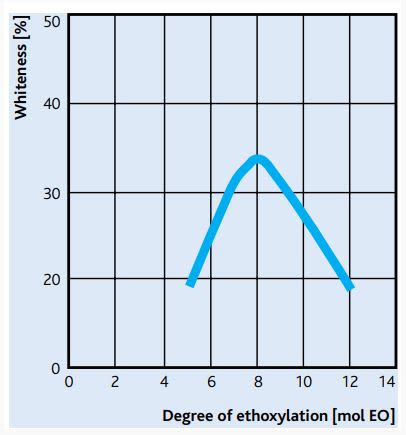
Detergency on cotton/polyester blend at 60 °C
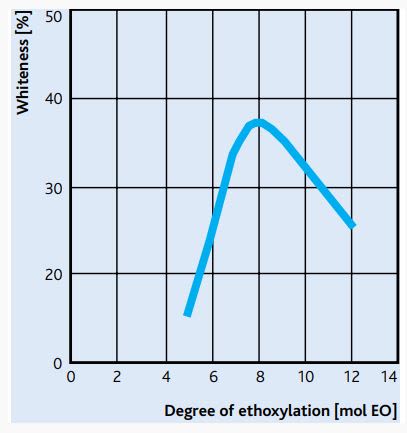
Detergency on cotton at 60 °C
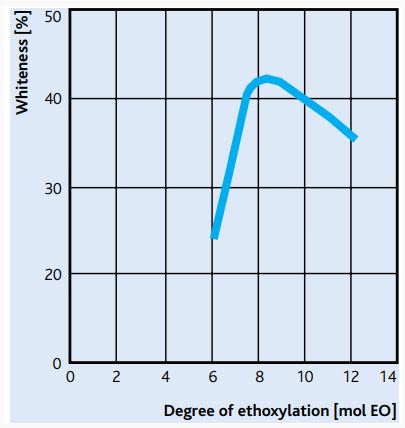
Detergency on cotton at 90 °C

Packaging & Availability
- Country Availability
- Regional Availability
Storage & Handling
- Storage And Handling
Precautions for safe handling
Advice on safe handling
- Wear personal protective equipment. Avoid contact with skin and eyes.
Advice on protection against fire and explosion
- Normal measures for preventive fire protection. Do not spray on a naked flame or any incandescent material.
Fire-fighting class
- B: Fires involving liquids or liquid containing substances. Also includes substances which become liquid at elevated temperatures.
Conditions for safe storage, including any incompatibilities
Requirements for storage areas and containers
- Keep tightly closed in a dry and cool place.
Storage class (TRGS 510)
- 10-13: German Storage Class 10 to 13
Other data
- Stable at normal ambient temperature and pressure.
- Transporation Road tankers, about 950 kg containers, about 190 kg enameled iron drums
- Storage: Stainless steel vessels (Steel no: 1.4541 or 1.4571)

